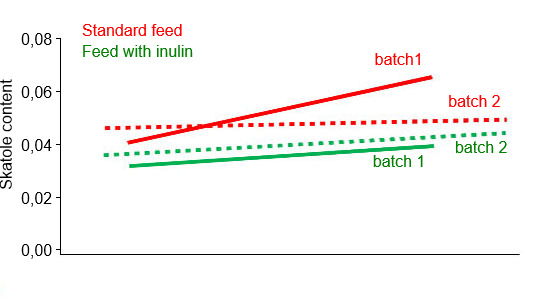Piglets are routinely castrated in many countries, without anaesthesia or analgesia to avoid the presence of boar taint in pork. The entire males pigs grow faster, convert feed more efficiently, with lesser nitrogen in manure and, produce leaner carcasses compared with castrated pigs. Consumer voices defending animal welfare consider unnecessary to inflict the pain and suffering due to castration on piglets and, in the EU the stakeholders are voluntary committed to stop routine surgical castration without anaesthesia or analgesia of pigs.
Two main compounds are responsible of boar taint, androstenone and skatole. Androstenone is a male steroid pheromone while skatole and indole are breakdown products of tryptophan metabolism. The consumer acceptance thresholds for androstenone and skatole range from 0.5 to 1.0 and 0.2 to 0.25 ppm, respectively.

Several alternatives to avoid castration has been use as the flow cytometric for sorting semen without the Y–sex chromosome, and immunocastration of male pigs based on the administration of an anti-gonadotropin-releasing hormone vaccine. Both approaches have not been implemented in Europe. The flow cytometric is too time consuming and public attitudes to immunocastration are largely unknown.
A more realistic way to avoid the risk of boar taint is to achieve the reduction of skatole and androstenone through feeding, breeding and management techniques. Skatole can be found in high concentration in pig faeces, so if pigs are reared in a dirty environment it can be absorbed through the skin, increasing the risk of boar taint. The use of slatted floors in the growing pens and low stocking densities decrease skatole levels in fat. Fasting animals for more than 14 hours prior transport and clean lairage conditions reduce fat skatole levels.
Skatole also can be reduced through diet changes prior slaughter. Skatole is synthesized and absorbed in the colon from either tryptophan from non-digestible protein or microbial degradation in the colon and its deposition is mainly in adipose tissue. Fermentable carbohydrates, such as sugar beet pulp, high amylase barley, chicory inulin and raw potato starch reduce skatole level in adipose tissue. Chicory inulin supplements stimulates the enzyme activities involved in the skatole oxidation.
The relatively high heritability of androstenone and skatole makes possible genetic selection for animals with low boar taint. Also, individual genes quantitative trait loci (QTLs) and DNA markers influence boar taint. The variations in the results suggest that boar taint is the product of small effects in many genes and it is the most probable that molecular approaches cannot provide the whole answer.
Hortós et al., (2015) recently demonstrated the benefits of the use of feeding and environmental conditions on boar taint reduction in pork from entire males sired from boars genetically characterized for high and low boar taint. Semen of 32 boars selected for a low or high Estimated Breeding Value (EBV) for skatole was used. Pigs were distributed into two batches. In both batches, during the last two weeks before slaughter, half of the pigs from each genetic level were fed this same diet with a 9% supplementation of chicory root extract which provided a 7% supplementation of inulin. Methane (CH4), ammonia (NH3), carbon dioxide (CO2) and nitrous oxide (N2O) concentration in the barns were measured. Subcutaneous fat was sampled, boar taint scored with a laboratory human nose score and the concentration of skatole and androstenone were determined.
The environmental emissions had shown differences in the conditions set between first and second batches. Thus, the emissions of methane, carbon dioxide and ammonium were higher in the batch 1 in winter compared with batch 2 in summer (Table 1). Heat and limitations in the air circulation in order to maintain a comfortable living temperature in winter was considered the main reason for the observed differences. As shown in Figure 1, in both batches the inulin diet group shows fewer cases with a high skatole content. In fact, inulin supplementation reduces the average skatole content of a wide range of slaughter pigs by one third. In batch 1, with poorer environmental conditions than batch 2, the progeny from sires with high skatole EBVs express their genetic potential by showing higher fat skatole contents when fed the standard diet. However, in batch 2 where pigs were keep in a clean environment a different pattern is shown. The progeny of sires with high EBVs do not express that undesirable potential on the standard diet in batch 2. These results support both approaches to reduce the risk of boar taint, although inulin supplementation is effective in different environmental conditions, the use of sires with low boar taint genetic potential seems more effective in dirty environmental conditions.
Table 1. Air content (mg/m3) of methane, carbon dioxide, nitrous oxide and ammonia in the finishing farm, per batch.
| Batch 1 | Batch 2 | |
| CH4 | 12.4 | 2.53 |
| CO2 | 7 132 | 2 170 |
| N2O | 1.00 | 1.13 |
| NH3 | 56.0 | 13.9 |

The following recommendations can reduce the risk of boar taint.
- Keep the pig house clean with the air levels of ammonia, methane and CO2 low.
- Supplement the feed with inulin as chicory root extract few weeks prior slaughter.
- Use progeny from parent animals with low genetic potential for boar taint.


